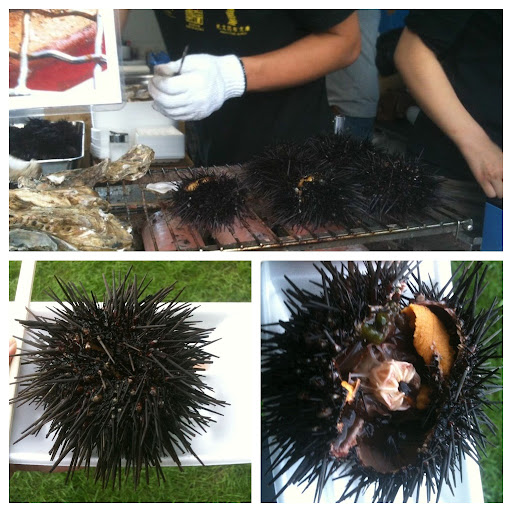
When I left Sapporo at the end of July, Odori Park was in the midst of a summer beer festival. When I returned in September, it had moved onto an autumn food festival. Me and this city were bonding.
On Friday lunchtime (a public holiday before you accuse me of skiving off) the festival stalls were bursting with different foods; crab was being cooked in its shell, skewers of chicken, beef and golden potato dumplings lay on a grill, deep fried balls of octopus sat in rows along with corn on the cob, pots of chowder, curry with giant naan breads, oysters in the half-shell...
... and spiny black balls that looked like hand grenades.
I did a double take as someone passed me with two balanced on a plastic plate. Was this a military training exercise or a snack with extra punch? Should I wrestle the man to the floor and call the police or... watch while he cracks one of the demonic spheres open and probes it with chopsticks. I tried to take a photo so I could demand answers from a safer distance but black spines on a black ball had stealth bomber properties for my phone camera. Short of propping my handset on the guy's shoulder (... no), I wasn't going to get a decent shot.
I had to find out where these came from.
I pushed back through the crowd, searching for people with similar platters of terminator snack food or the location of a high security military camp; one of the two. Eventually, I came across a grill that was advertising food from Rebun, an island off the northern coast of Japan. Judging from the map, it would indeed be the perfect place for a biological warfare unit.
I joined the queue.
Then something rather miraculous happened: my Japanese came through. Two places in front of me, I distinctly heard the woman order 'uni' meaning 'sea urchin'. I had eaten sea urchin before; it was a luminous orange, salty semi-liquid of a sea food. I'd had it with a rice bowl and on sushi but never ... well, in a sea urchin.
I tried to squint through the cracks of the grilling hand grenades to see if I could recognize the interior flesh. Different colours unhelpfully met my eyes. Still, since we seemed to be on a linguistic role, there was another option:
"Sore wa uni desuka," I inquired as I reached the counter.
Is that sea urchin?
The woman gave me a cheery smile, "Uni desuyo."
Yes, it is.
Comprehension AND communication! I was on fire.
"Ichi." I held up one finger.
In Japanese, numbers are usually followed by counters; words that indicate the type of object being enumerated. However, I had no idea what the counter for black-spiky-sea-urchin-bomb would be, so the request for 'one' was all she got.
I scuttled off to the corner of the lawn with my prize and pried it open with my chopsticks. Inside, there was the familiar orange strips that I had previously eaten, surrounded by green goop. What was the edibility factor for the green goop? Where a score '10' sees you ordering more and a '1' means that it is served at your funeral for company in the afterlife? Unfortunately, I had run away from the other urchin-bomb customers so I had no one close to compare eating habits to. In the end, I concluded that if anything green had to be definitely avoided, this would be one dangerous little number to serve up at a festival. Since no one seemed to be in charge of carrying off dozens of corpses, I ate all the orange, some of the green (I'll give it a '7') and decided that was enough excitement for one meal time.
Later, I looked up 'sea urchin' on wikipedia. Apparently, the orange delicacies are actually the sexual organs. Not all knowledge is good.